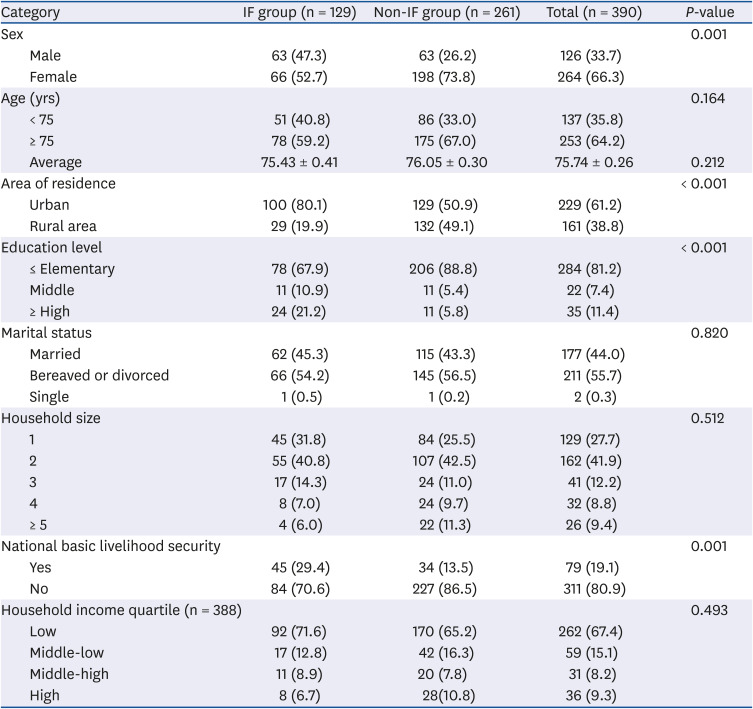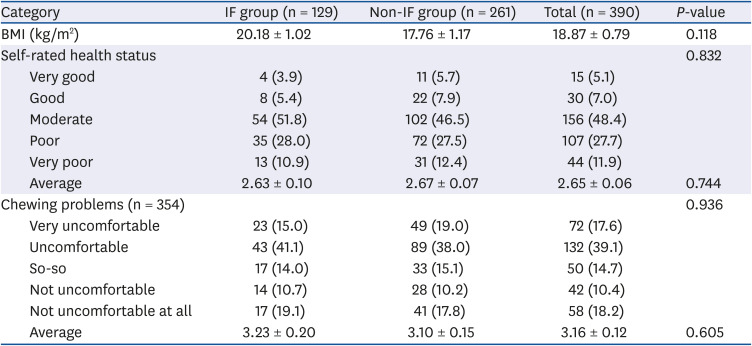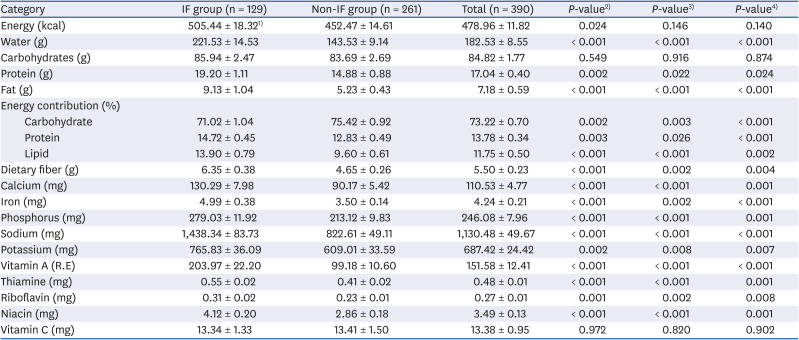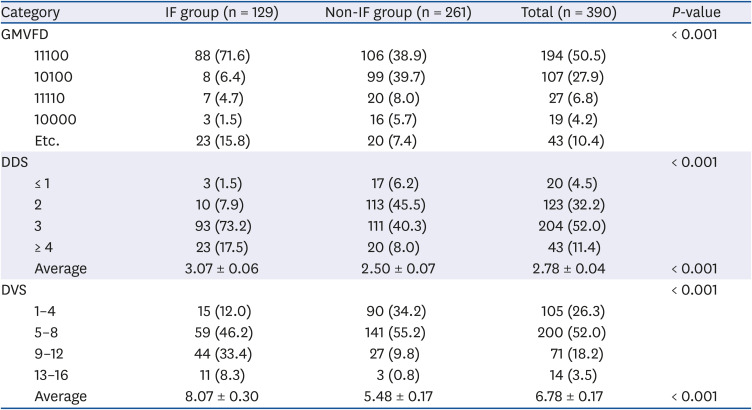1. He W, Goodkind D, Kowal P. An Aging World: 2015. Washington, D.C.: U.S. Government Publishing Office;2016. p. 32–33.
4. Korean Ministry of Government Legislation. Welfare of the aged act [Internet]. Sejong: Korean Ministry of Government Legislation;2019. cited 2020 March 2. Available from:
http://www.law.go.kr.
5. Jung HY, Yang IS, Lee HY, Chae IS. Analyzing the current congregate meal service program for homebound elderly. Korean J Community Nutr. 2003; 8:919–926.
6. Jung HY, Yang IS, Chae IS, Lee HY. Analyzing the operational differences of foodservice center for homebound elderly by the presence of the dietitian. J Korean Diet Assoc. 2004; 10:197–204.
7. Suh HJ, Lee Y, Jang Y, Kim B, Lee H, Kim CI. Current status and management of congregate meal service program for the elderly at community centers. J Korean Diet Assoc. 2004; 10:333–344.
8. Seo J, Kwon KI, Kim GH. Study on the actual conditions of institution foodservice management in the elderly welfare facilities by the employment of dietitians. Korean J Food Cookery Sci. 2019; 35:216–225.

9. Yoon MO, Moon HK, Jeon JY, Sohn CM. Nutritional management by dietitian at elderly nursing homes in Gyeonggi-do. J Korean Diet Assoc. 2013; 19:400–415.

10. Kwon JS, Lee SH, Lee KM, Lee Y. Study on energy and nutrient intake and food preference of the elderly in care facilities. Korean J Community Nutr. 2016; 21:200–217.

11. Lee KH, Park JR, Seo JS. Nutritional status of the elderly living in a private silver town of Busan metropolitan city, Korea. J Korean Soc Food Sci Nutr. 2007; 36:1293–1299.

12. Chae IS, Yang IS, Lee HY, Park MG. Evaluation of home-delivered meals service program for home-bound elderly with low income class. J Korean Diet Assoc. 2000; 6:57–70.
13. Park JY, Lee KE, Yi NY, Kwak TK. Clients’ handling and consumption of home-delivered meals at home and their perceptions on home-delivered meal services for older adults. Korean J Community Nutr. 2010; 15:379–392.
14. Choi JH, Kim DH, Choi EH, Chung MJ, Lee HS, Lee MJ, Chang HJ, Lee KE, Kwak TK. Assessment of food service management practices according to types of elderly foodservice facilities. J Korean Soc Food Sci Nutr. 2019; 48:469–481.
15. Kim YS, Park YS, Choi BB. Foodservice characteristics and satisfaction of the elderly with the welfare facilities in the northern Gyeonggi-do area. Korean J Food Nutr. 2014; 27:872–880.

16. Lee MJ, Kim JH, Park OJ, Lee YM. A study on the needs for nutrition management program for elderly who use welfare facilities. Korean J Community Nutr. 2016; 21:65–74.

17. Kang P, Jung HY. A study on needs and satisfaction of elderly community meal service in rural area. Culin Sci Hosp Res. 2019; 25:181–189.
18. Han KH, Choi MS, Park JS. Nutritional risk and its related factors evaluated by the Mini Nutritional Assessment for the elderly who are meal service participants. Korean J Nutr. 2004; 37:675–687.
19. Lee S, Ryu H, Song K, Lee H. Depression symptom, anthropometric assessment and nutrient intake of elderly females who eat congregate meals at lunch in rural area. Korean J Food Nutr. 2015; 28:517–526.

20. Son SM, Park YJ, Koo JO, Lee YN, Yoon HY. Nutritional and health status of Korean elderly from low-income, urban area and improving effect of meal service on nutritional and health status- V. the effect of meal service for one year on nutritional and health status. Korean J Community Nutr. 1997; 2:63–73.
21. Ministry of Health and Welfare. Dietary reference intakes for Koreans 2015. Sejong: Ministry of Health and Welfare;2015.
22. Guthrie HA, Scheer JC. Validity of a dietary score for assessing nutrient adequacy. J Am Diet Assoc. 1981; 78:240–245. PMID:
7217578.

23. Kant AK, Block G, Schatzkin A, Ziegler RG, Nestle M. Dietary diversity in the US population, NHANES II, 1976–1980. J Am Diet Assoc. 1991; 91:1526–1531. PMID:
1960344.

24. Drewnowski A. Taste preferences and food intake. Annu Rev Nutr. 1997; 17:237–253. PMID:
9240927.

25. Kim HR. Status of group lunch and improvement of nutrition management. Health Welfare Issue Focus. 2012; 130:1–8.
26. Yoon JS, Song MK, Lee HJ, Lee SY, Cho HK, Choi YJ. An evaluation of the dietary status for developing assistance programs for daily lives of elderly individuals in rural Korea. Korean J Community Living Sci. 2014; 25:163–173.

27. Baum JI, Kim IY, Wolfe RR. Protein consumption and the elderly: what is the optimal level of intake? Nutrients. 2016; 8:359.

28. Velho S, Marques-Vidal P, Baptista F, Camilo ME. Dietary intake adequacy and cognitive function in free-living active elderly: a cross-sectional and short-term prospective study. Clin Nutr. 2008; 27:77–86. PMID:
18082291.

29. Han GS, Yang EJ. Evaluation of dietary habit and nutritional intake of Korean elderly: data from Korea National Health and Nutrition Examination Survey 2013–2015. J East Asian Soc Diet Life. 2018; 28:258–271.

30. Roberts SB. Effects of aging on energy requirements and the control of food intake in men. J Gerontol A Biol Sci Med Sci. 1995; 50:101–106. PMID:
7493200.
31. Jung HJ, Song WO, Paik HY, Joung H. Dietary characteristics of macronutrient intake and the status of metabolic syndrome among Koreans. Korean J Nutr. 2011; 44:119–130.

32. Jung EK, Park S, Kim JS. Evaluation of the menus of senior welfare centers for home-bound elderly. J Korean Diet Assoc. 2017; 23:363–373.
33. Park S, Ahn SH, Kim JN, Kim HK. Sodium content and nutrients supply from free lunch meals served by welfare facilities for the elderly in Gyeonggi-do. Korean J Food Nutr. 2013; 26:459–469.

34. Lee Y, Choi Y, Park HR, Song KH, Lee KE, Yoon CH, Lim YS. Comparative analysis of dietary behavior and nutrient intake of elderly in urban and rural areas for development of “Village Lunch Table” program: based on 2014 Korea National Health and Nutrition Examination Survey data. J Nutr Health. 2017; 50:171–179.











 PDF
PDF Citation
Citation Print
Print



 XML Download
XML Download